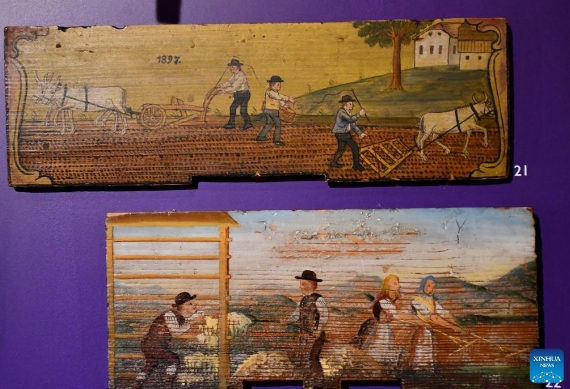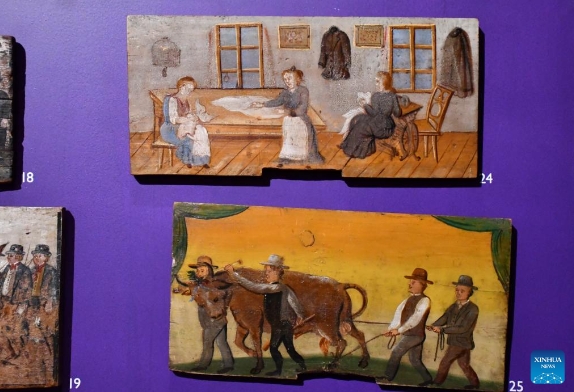Slovenian beekeeping tradition to shine at China exhibition

Painted beehive panels are exhibited in the Slovene Ethnographic Museum in the center of Ljubljana, Slovenia on May 19, 2024. (Xinhua/Zhou Yue)
The Slovene Ethnographic Museum will showcase Slovenian beekeeping traditions at an upcoming exhibition in Xi'an, an ancient capital in northwest China's Shaanxi Province, to mark World Bee Day.
The exhibition, to be held at the Qujiang Museum of Fine Arts later this year, will feature painted beehive panels and highlight Slovenia's rich heritage in beekeeping.
World Bee Day, which falls on May 20, was declared in 2017 when the United Nations accepted Slovenia's proposal to celebrate bees annually on the birthday of Anton Jansa, Slovenia's pioneer of beekeeping.
Slovenia, a mountainous country with 2.1 million citizens, boasts 11,000 beekeepers -- the highest number per capita in the world. Its beekeeping and beehive panel painting tradition is inscribed in the intangible cultural heritage list of the United Nations Educational, Scientific and Cultural Organization.
"The focus of the exhibition will be on painted beehive panels," said Bojana Rogelj Skafar, curator of the Slovene Ethnographic Museum for the Xi'an exhibition. "There are as many as 600 various subjects of painted beehive panels in existence, including religious scenes as well as those from everyday life."
Slovenian beekeeping is known for its colorful hive panel paintings. Experts indicate that traditional practices sustained that these paintings helped bees recognize their hives in densely populated areas. Over time, this practice evolved into a form of artistic expression, with themes shifting from religious to daily life scenes.
The earliest painted beehive panels date back to 1758. Early painting materials used natural pigments and linseed oil applied to the surface to make the colors last. It is only after the 19th century that industrial pigments started being used, experts indicate.
"We can be proud of this artistic tradition, but it remains an enigma why it has not spread into wider European area," Skafar added, pointing out the uniqueness of this ancient practice. "People enjoyed painted beehives -- they were like outdoor galleries."
Traditional beekeepers believed that painted hives had a protective function, ensuring healthy and productive bees, she said. However, only a few beekeepers have kept on the tradition in modern days.
Beehives are commonly installed on rooftops of Slovenian cities, notably on the roofs of Ljubljana's largest cultural and congress center, the Cankar Center, and the state radio channel, Radio Slovenia.
According to Skafar, 60 panels will be exhibited in Xi'an, along with traditional molds to produce small gingerbread pieces and photos of various in Slovenia.
The exhibition will also feature urban beehives in line with modern awareness of care for the environment. "We want to take to China and the world a message that bee products are beneficial to human health, and that humans must keep the environment healthy to enable the survival of bees," Skafar said.
Curators and organizers of this exhibition hope the event will also be staged in other Chinese cities.
The Ethnographic Museum, located in the center of Ljubljana, collaborates with Chinese counterparts on several levels. In September last year, the museum invited experts from Beijing's Palace Museum to inventory and restore Chinese artifacts collected by Slovenian navy officer Ivan Skusek during his stay in China from 1914 to 1920. Skusek's collections will be exhibited later this month.
Last month, the museum also co-organized the United Nations Chinese Language Day celebrations with the Confucius Institute Ljubljana.

Painted beehive panels are exhibited in the Slovene Ethnographic Museum in the center of Ljubljana, Slovenia on May 19, 2024. (Xinhua/Zhou Yue)
Editor:伏娅敏
